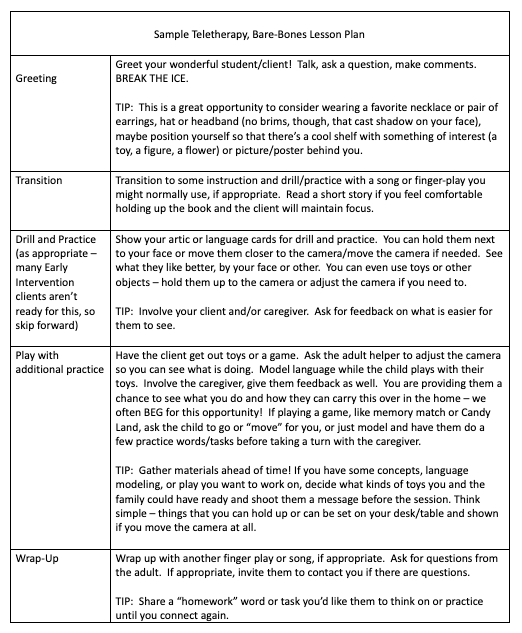
But What Does Telepractice LOOK Like?
March 24, 2020
The scrambling continues, more and more questions arise, you’re in a tumultuous state of limbo between your own social-distancing needs, stress is rising…and your employer has issued the decree: move to telepractice for the foreseeable future.
Before you continue, give your brain some oxygen. Close your eyes, take a deep breath and let it out while you count slowly to ten. Repeat if necessary.
It is going to be okay.
If you’re still feeling hit by a baseball bat with absolutely no idea which way is up from tech/setup needs to performance anxiety, may this help you. First, let’s review some very basic considerations as you prepare for emergency telehealth services.
Do you have:
- Reliable high-speed internet
- A reliable computer
- Camera (built into your laptop, an external one that sits on top of a laptop/monitor)
- Microphone (either built-in, part of the external webcam, a stand-alone plug-in mic, or part of a headset such as gaming headsets, cell phone headsets, etc.) Speakers/Headset
- A platform to connect on (e.g., Zoom, BlinkSession, Theraplatform, Google Classroom, FaceTime, etc.) The US Department of Health and Human Services has waived the requirement of fully-HIPAA compliant platforms during this crisis, but if you have the ability to maintain that with a platform that already IS compliant, it is highly encouraged.
Do your families/students/clients have these, plus: - A parent/caregiver who will be with the student/client until it is certain that they can participate independently
- In lieu of a computer, with the restrictions of HIPAA compliance lifted temporarily, families with limited access to tech can use a tablet or phone for many of the accepted platforms right now (e.g., Zoom has an app, Skype, FaceTime…other platforms may also have mobile apps). This is a huge consideration for clients and families with socio-economic limitations.
If you are still stuck on the logistics above, you and/or your administration or team may still have decisions to make and you may not be ready to begin just yet! Take another breath – it is challenging to move forward when you don’t know what you don’t know.
If you can connect to your clients and families, now, that’s GREAT! But, wrapping your head around what therapy via this connection looks like is another thing entirely, and not one that’s being addressed as readily. How do you teach this way? What does it even look like?
I promise it’s not much different. And before long, you feel like it’s just about the same.
Understand that this delivery model is still face-to-face. You are still interacting, modeling, instructing, just as you do in your therapy room or classroom. You just have a barrier now: the screen. Sometimes it takes a little more explanation to complete a task, a little extra description. Decidedly, it stretches your language and how you provide directions – in positive ways! Grow with this; it will make you a stronger therapist.
Does the thought of a camera absolutely debilitate you? It is natural that the tiny eye of a camera suddenly induces performance anxiety. It’s new. New and unknown equates a bit of anxiety. It’s akin to having your supervisor observe you or a parent in the therapy room for the first time – these things make many of us nervous! Accept that it is just a new set of eyes, as when you get a new student or someone else is joining your session. Your nerves indicate that you care about doing well. Understand where that comes from, accept that feeling being there, and then do what you know.
You do speech! You teach! You provide strategies and feedback! Do what you do in your sessions!
Here is a sample framework for your remote sessions that you may find useful from PreK through elementary. Middle and high school clients usually need less song and dance and participate with verbal exchange, auditory memory, or fill-in-the-blank types of drills. Feel free to use this or brainstorm with it! This is very basic, considering just a simple setup: you have your computer/device, your platform, and you connect for a session – no need to have multiple cameras and screen sharing, or interactive features just yet, if all of that tech and multi-tasking is overwhelming to you. That can come later, if needed:
This is a very basic example intended to show you that just getting started, you don’t have to be fancy, or reinvent the wheel. Getting connected and accomplishing some interaction will boost your confidence and you’ll feel better about delivering services via teleconnection!
Remember, my friends: It’s going to be okay. No one could have been prepared for this, in this capacity, but here we are. We can stick our heads in the sand, or we can act. It might not be perfect, it certainly may not be pretty, but we’re going to make it. We are not alone.
If you are still feeling unsure, please reach out!
Here is Angela’s contact information: email address: angelasaus@gmail.com Twitter handle @CrissXAppleSaus
About the Author:
%20copy.jpg)
Angela Saus graduated from Truman State University and has 21 years in the field of speech pathology. She spent 18 years in the schools in early childhood special education before heading to telepractice for 3 years. Telepractice allows Angela to still be in the schools, just in a different way. Her interests include early childhood development, language development, literacy, play, functional skills for the severely delayed learner, and sensory integration. She contracts with TinyEYE and with schools in Missouri, California, and Wyoming. When Angela is not wearing her SLP hat, she loves to read and write, listen to musical scores, run, and build/wear costumes for charity appearances.
When asked about SLP Toolkit, Angela responded, “I love organizational tools, so the fact that I can be organized for data tracking, progress monitoring, goal writing, and billing, along with everything else, is great.”.




